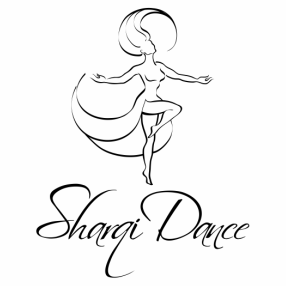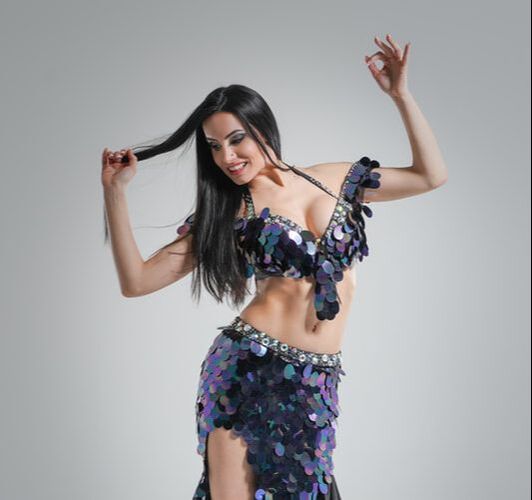|
Learn About the Genre of Egyptian Music and Dance that Gives Belly Dance Much of Its Essence Baladi (بلدي, alternatively spelled beledi or balady) means "from the country, "of the country," or depending on the context, "my country," and while in Arabic it can refer to any country or anything from a given country, when belly dancers talk about it, we are usually referring to the Egyptian music and social dance styles that evolved when people from Egypt's rural areas started migrating to the cities. In the larger cities, the folkloric music that originally came from Egypt's rural areas and was played with traditional Middle Eastern instruments such as the ney or mizmar gained influence from the music of Western countries (Egypt was colonized by both the French and the British at different points in its history), and Western instruments such as the accordion, saxophone, keyboard, and others were adopted. A common style of baladi music called baladi taqsim or baladi progression usually follows a loose pattern in which a melodic instrument such as an accordion, saxophone or ney ebbs and flows as the primary instrument, while the tabla (drum) keeps a steady rhythm in the background. The music goes through distinct sections: a solo by the primary melodic instrument without any rhythm, a call and response section between drums and melody, a section with slow melody and steady rhythm, and a section where the melody gets faster and is accompanied by faster drums, which eventually build up to a climax or a drum solo. This structure, of course, is not always followed in this order and not all of these sections are found in every song. The structure varies from song to song. Baladi music is usually improvised, and therefore baladi dancing is usually improvised on top of improvised music! Watch Fifi Abdo Dance to a Baladi Progression It's no wonder Fifi has been dubbed "Queen of Baladi"! Raqs baladi (baladi dance) is, essentially, the social form of raqs sharqi (Oriental dance, more commonly known in Western countries as "belly dance").
Belly dance was adapted for the stage from social, folkloric, and performance dances from Egypt and other Middle Eastern countries. As it has subsequently evolved, elements such as a wider use of space and spacial patterns, arm movements and frames with extended lines, and complex footwork and weight shifts were adopted in order to make it more interesting and visible from a distance, and more appealing to Western eyes and tastes. The two-piece costume that is commonly associated with belly dance was also adopted around that time. But at its root, belly dance comes from Middle Eastern dances that focus on the movement of the hips, such as baladi, which has a very heavy, earthy and grounded look and feeling. In a way, baladi is like the heart of belly dance... and for that reason, it holds a special place in most belly dancers' hearts. Belly dancers study baladi not only because raqs sharqi is so influenced by raqs baladi, but also because often, we perform baladi as part of our performances. It comes up often as sections within the music we use, or sometimes we perform to a whole baladi song by itself, or as part of our longer performance sets that include a variety of musical genres. When performing baladi on its own, dancers will usually wear a galabeya, the traditional garment worn in Egypt which looks like a long "dress" with long sleeves, like the one Fifi Abdo is wearing in the video above. Or sometimes a more form-fitting, colorful and sparkly galabeya will be worn instead. Or, if the dancer is performing baladi as a part of a full belly dance performance set with multiple songs, the dancer might be wearing the more standard two-piece costume instead. To truly do justice to our art form, we must understand our music, where it comes from, how to dance to different genres of Middle Eastern music, and how to dress appropriately. Was this post helpful? Would you like to learn more about baladi? Hit "like" below and leave a comment with your feedback! You can also visit our blog map to find more posts like this, or subscribe to our newsletter, YouTube channel, or Facebook page to be the first to find out about our next post. Happy learning, and happy dancing!
8 Comments
6/29/2020 09:40:36 pm
Thanks for sharing! You did very well explaining Raqs Baladi.
Reply
6/29/2020 11:08:24 pm
Thank you for your comment Natalie, I'm glad you enjoyed the article. I love your baladi dancing <3
Reply
Ariya L
7/13/2020 01:34:22 pm
Thank you for this interesting article. Can you tell me what kind of dance was the 'danse du ventre' performed at the 1889 Paris Exposition, in the cafe of the Cairo Street? And what kind of dance is performed by Fatima Djemile in Edison's film "Little Egypt" from 1896? These seem to predate raqs sharqi, which I have read dates from the 20th century. Does this mean their dance is baladi? Or something else? Thank you for any information you can provide, or any hints on where to go to find out more about 19th century belly dance in the western world.
Reply
7/13/2020 01:58:15 pm
Hi Ariya,
Reply
Angela
10/17/2023 02:19:51 am
Do you have anything before the 1600s on egyptian baladi style of dance?
Reply
Leave a Reply. |
AuthorYamê is a Brazilian-American View Posts By CategoryIf you'd like to read more articles by Yamê or SharqiDance's guest authors, please view our blog map here.
Archives
January 2024
|


 RSS Feed
RSS Feed